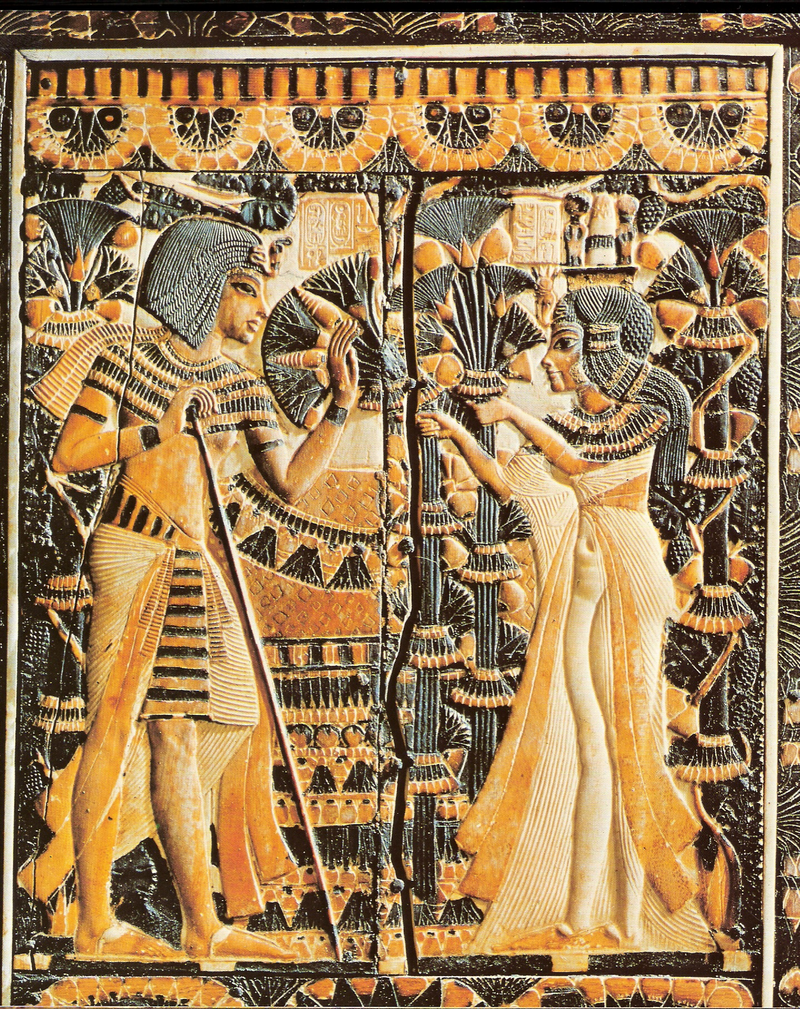
By Tiger Cub – own work, Public Domain,
King Tutankhamun is one of the most famous rulers ever, thanks to Howard Carter‘s 1922 discovery of the pharaoh’s tomb in Egypt’s Valley of the Kings, sponsored by British aristocrat George Herbert. The find stirred the imaginations of millions fascinated by the boy king’s golden-masked mummy.
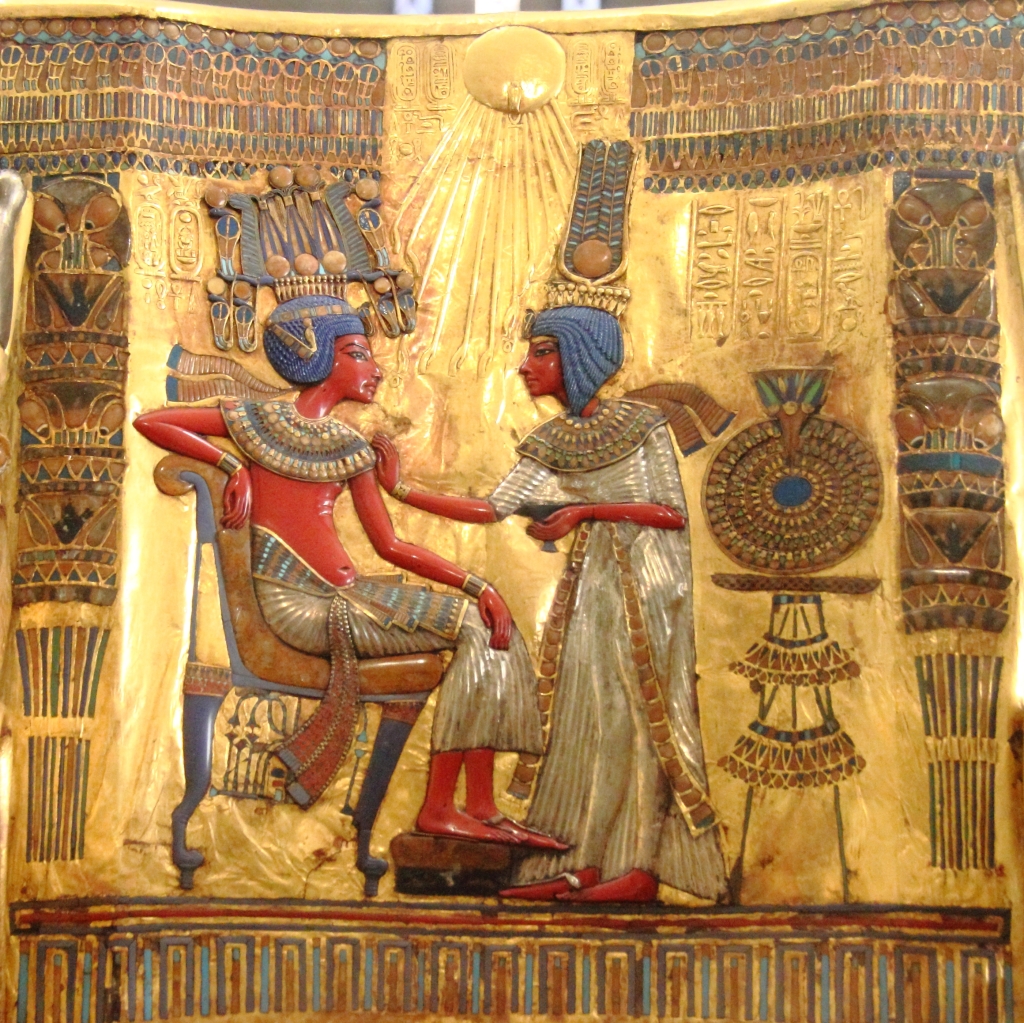
By Djehouty – Own work, CC BY-SA 4.0,
He and his tomb are (one of) the most beautiful and, tragically, the most robbed and plundered in ancient Egyptian explorations. No wonder the shining gold and humans’ greed! Nonetheless, the efforts of the good side of humans still try to restore and discover more details of the life of this fascinating man, and they will continue for sure!
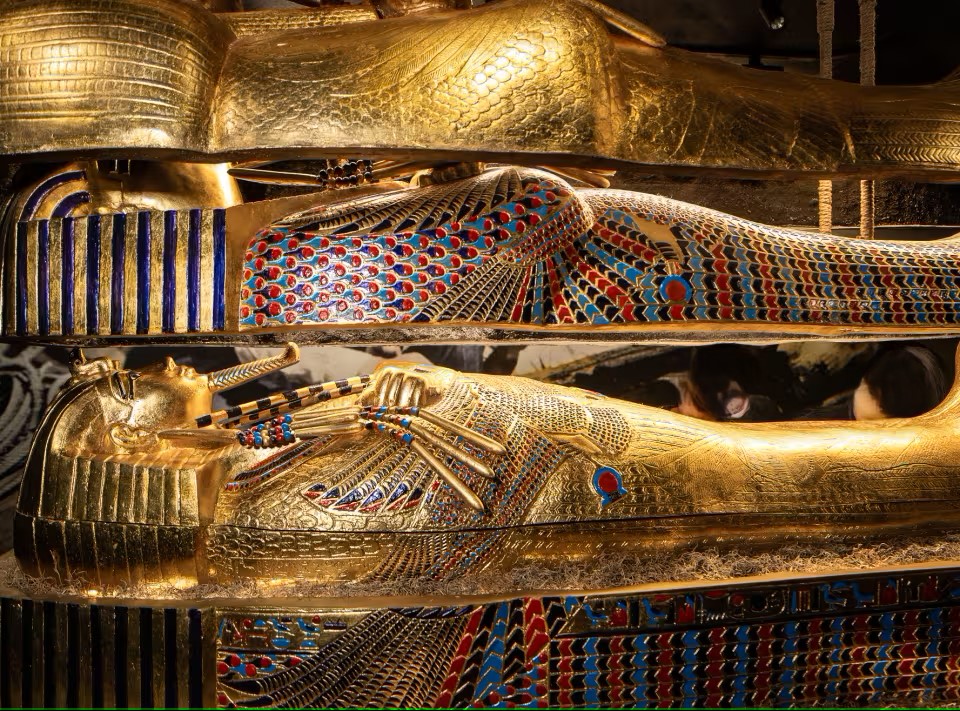
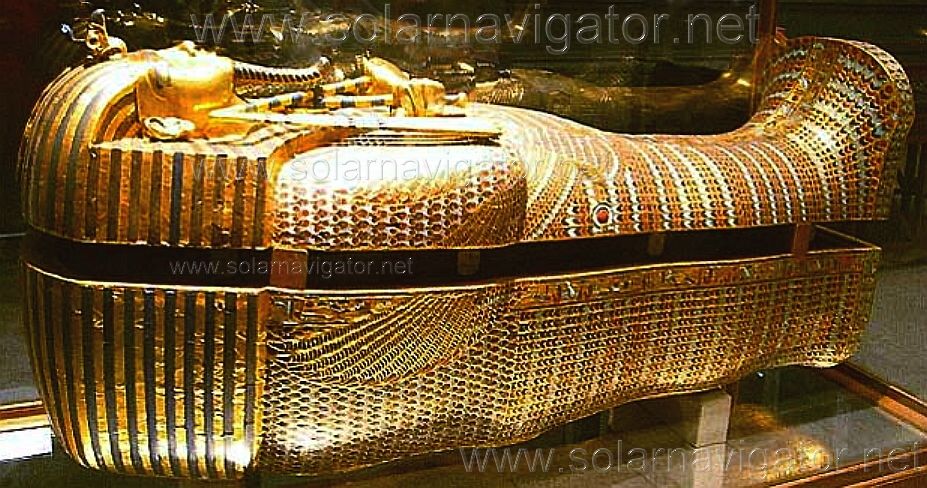
Here, we read an exciting story by Marie Grillot and Marc Chartier about a deep investigation and discovery using modern technology.
Tutankhamun: the story continues…
via égyptophile
In November 1922, after ten years of excavations and research in the Valley of the Kings, Howard Carter and Lord Carnarvon finally discovered the first step of Tutankhamun’s tomb, which they had been desperately searching for.
Within this KV62, with an area of just over 100 m², a team of the best experts will work on clearing and saving the objects. Some will devote nearly ten years to it, and the whole world, fascinated by this young pharaoh emerging from oblivion, will marvel at the priceless treasures surrounding him for his afterlife.
For more than 90 years, the number of visitors who have entered the pharaoh’s tomb to absorb a small part of his eternity has continued to increase, endangering his survival. The humidity generated by these visits significantly deteriorated the paintings and generated mould, causing significant damage. This led the Antiquities Department to limit the number of daily visits and close access to the site to the public in 2011.
This context, which seemed inevitable, was understood in 2002, and the basis for constructing a replica of the KV62 was studied.
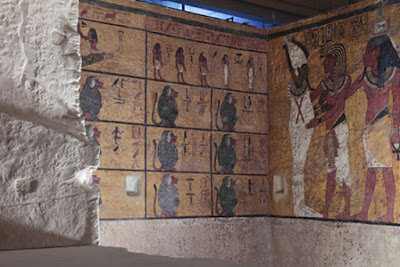
Illustration Factum Arte
The company Factum Arte, founded by the British painter Adam Lowe and based in Madrid, was chosen to build this replica. The Egyptian Ministry of Tourism and Antiquities and funds from the European Union partially financed it.
Experts in these new technologies have implemented, used, and piloted innovative techniques, the most advanced of which is 3D. In 2009, for many months, the Factum Arte team invested in the tomb to memorize every centimetre with the highest precision. “The first work consisted of carefully recording the relief of the walls and the sarcophagus with a scanner specially designed for the occasion. Its resolution reached one hundred million points per m². Then, the second stage consisted of photographing the paintings with a very high resolution and faithfully respecting the colours.”
Armed with this data, Factum Arte technicians returned to their premises in Madrid, where they began manufacturing the facsimile in the form of hundreds of high-density polyurethane panels. These were assembled on-site to form the four walls of the mortuary chamber. The inauguration of the “double” tomb took place in April 2014.
And this is where another part of this beautiful story begins…
Egyptian Minister of Antiquities, Mamdouh Al Damati, listening to British Egyptologist Nicholas Reeves,
near the sarcophagus of Tutankhamun – Photo: AFP/ Khaled Desouki
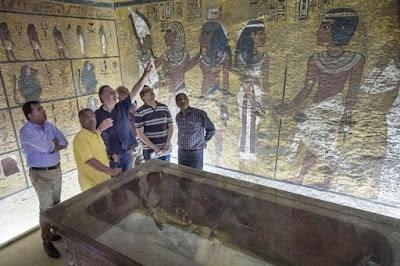
Nicholas Reeves, an English Egyptologist and foremost specialist in Tutankhamun, carefully studies the photos taken by Factum Arte in the burial chamber. This room is the only one in the tomb, and it is decorated with paintings: “rudimentary, classic, of austere simplicity” executed on a plaster coating painted yellow. These paintings reflect the ritual name given to it in antiquity: “the Hall of Gold.” He then noticed reliefs which could be blocked openings overtures onto two rooms unexplored until now. By pushing further his reasoning, he believes that one wall (the north wall) would be Queen Nefertiti’s burial place, while the other (the west wall) would be a storage space.
Nicholas Reeves supports his hypothesis – contested, it is necessary to recall, by other Egyptologists – first of all on his interpretation of the frescoes of the northern wall of the tomb (which represent the young king Tutankhamun performing a funerary ritual for his mother, Queen Nefertiti), then on the fact that Tutankhamun died prematurely, at the age of 19, and that, due to lack of an available tomb, the priests would have taken the decision to reopen Nefertiti’s tomb, ten years after his death, to bury the young king in a hypogeum not provided for him.
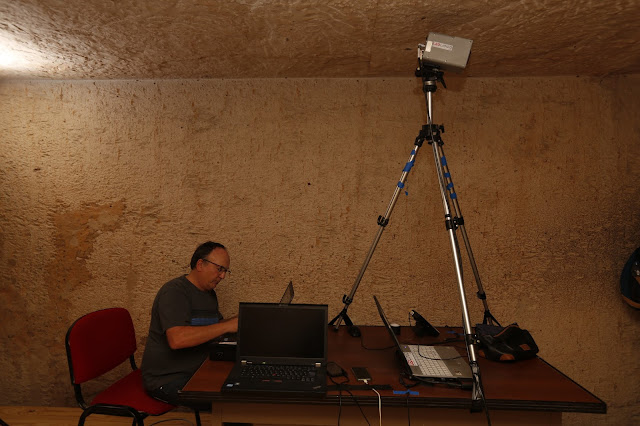
© http://www.HIP.Institute / Philippe Bourseiller
To verify this hypothesis, the Ministry of Antiquities has given the green light to enter noninvasive and nondestructive techniques onto the scene. First of all, infrared thermography is an operation led by Jean-Claude Barré, who came to Egypt as part of the “Scan Pyramids” mission. Based on images captured regularly over 24 hours, this technique can reveal temperature differences, possibly leading to cavities under a given surface. This was indeed the case in the tomb of Tutankhamun, where such temperature differences were detected through the painted coating of the north wall, without it being possible to determine the exact configuration of a hollow space or, even more so, its content.
After some tests in a tomb whose configuration is already known (the KV5) to verify the effectiveness and reliability of the equipment used, the second series of surveys in Tutankhamun’s tomb was carried out using the radar technique. This device was placed 5 cm from the wall to prevent damage.
During the press conference, held in Luxor on November 28, 2015 late in the morning, at the house of Howard Carter, the Minister of Antiquities, Dr. Mamdouh El-Damaty, announced that the radar scans revealed the existence of a large void, with a long corridor, behind what we now know to be a false wall (a “ruse”, a ploy, intended to thwart possible tomb robbers) in Tutankhamun’s burial chamber. It is helpful to remember that the tomb was robbed several times in antiquity.
Analyzes by Hirokatsu Watanabe, a Japanese radar specialist, also provide evidence of a second door hidden in the adjoining west wall.
The Minister declared, “We previously spoke of a 60 per cent chance that something was behind the walls. But now, reading the first analyses, we can assert a 90 per cent probability.”
He specifies that the data collected will quickly be examined more deeply in Japan.
He then mentioned a possible next step: digging a small hole in the wall (on an unpainted space) of the neighbouring room, called the “Treasure Room,” adjoining the “empty” behind the wall in the burial chamber to introduce a browser camera.
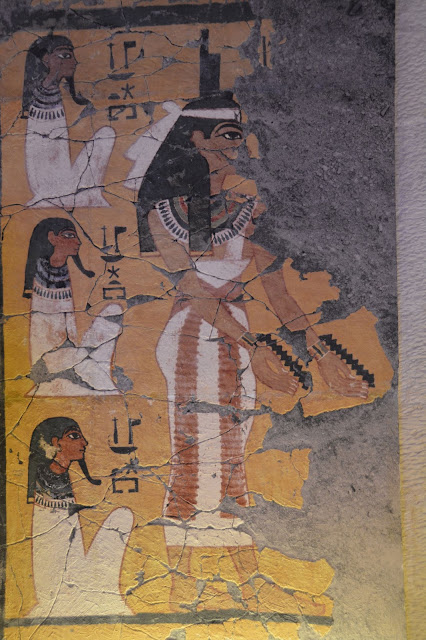
and reconstituted in the replica of the tomb – photo Marie Grillot
It is unthinkable to risk damaging or deteriorating these painted walls. It is helpful to remember that during the second season of excavation, Howard Carter destroyed part of the scene on the south wall and then recovered the fragments. Still, these practices are no longer used today.
The questions remain and even multiply… But one answer is inevitable: Tutankhamun has not finished being in the spotlight!
To complete the information:
http://news.nationalgeographic.com/2015/11/151126-nefertiti-tomb-tut-egypt-archaeology/ http://news.nationalgeographic.com/2015/11/151128-tut-tomb-scans-hidden-chambers/ http://english.ahram.org.eg/NewsContent/9/40/171833/Heritage/Ancient-Egypt/Radar-test-underway-before-search-for-Nefertiti-in.aspx

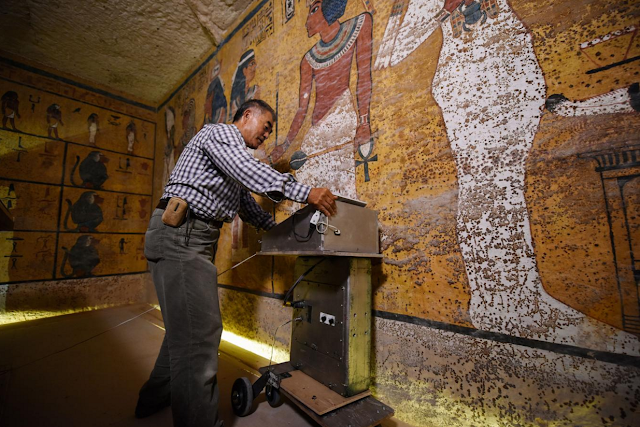
As always I found your post really fascinating. Thank you for sharing the result of your precious research, which made me discover the existence of a replica of the tomb in Spain 🩵
LikeLiked by 1 person
Oh, a good idea! Thank you, my dear friend.🤗🙏🤙💖
LikeLiked by 1 person
As always, you’re more than welcome!
LikeLiked by 1 person
🙏🥰🌟
LikeLiked by 1 person
When I arrived back in England in 2000, the one place I wanted to immerse myself in was the British Museum. That’s where I got up close with the replica gold mask of Tut. I’ll never forget it brother.
LikeLiked by 1 person
That was the time, dear brother.🤙✌
LikeLike
As a school girl, I vividly remember visiting the 1972 exhibition held in London. It was incredible, I loved everything, especially the jewelled pieces. I was mesmerised, I think the world was! Thank you for sharing more of Marie’s Egyptian magick! Love and light, Deborah.
LikeLiked by 1 person
Thank you, as always, my lovely angel. I just feel like I’m missing out on being unable to visit any great museums yet!😜😂🙏💖
LikeLiked by 1 person
Absolutely fascinating, Aladin.
I hope to still be here for the next discovery.
Around 1980 the AGO had for 1 month only, a King Tut exhibit that had been touring the UK, Russia and the USA since 1972, the Treasures of Tutankhamun.
I didn’t know much outside of Mummy movies. The public frenzie to see this show was contagious, and so I went.
The crowds were lined up daily, and were so long, one could only pass slowly by the artifacts. No lingering at all.
There was massive security. All of the artifacts were encased in glass display cases, which were temperature and moisture controlled inside each one.
Also, one could not get closer than several feet (maybe 3 – 5 feet) of a display case. There were rope barriers, and security at each display.
It was so expensive to go, I spent the money for some household bills to afford it. I had to catch up after that.
I was young, uneducated about Egyptology and was forced through the exhibit like a sheep or cow being herded with a thousand others.
Interestingly, the fact of the herding of the masses upset me to the point of frustration, then to disinterest in what I was allowed to glimpse.
I remember something large and gold, some small …like vases or so pieces, and nothing else in the show.
I do remember the actual experience well, though.
Anyway… I did go… so that is something.
❦🌹🌟 ❦🌹🌟
LikeLiked by 1 person
Oh, my dear. I think it is “unfortunately” somehow a matter of making money. I have the same feeling when I am on vacation and plan to look for an exciting tourist event, but I mostly avoid it because I do not want to be part of the famous crowd. Although I understand your passion for your young age, I would perhaps do the same.
The more mature, the wiser! Thank you for this cute anecdote of your memories.🤗😎💖🙏
LikeLiked by 1 person
🤗😎💖🙏
Welcome, Aladin, and thank you for taking the time to read!
LikeLiked by 1 person
With the whole pleasure!🥰🙏🤙💖💖
LikeLiked by 1 person
He is an eternal enigma! Great blog post!
LikeLiked by 1 person
That is true, dear friend. Thank you so much.🙏🤙
LikeLiked by 1 person
You’re welcome!
LikeLiked by 1 person
That’s so interesting! Always good to read about Tutankhamun and Nefertiti.💛✨
LikeLiked by 1 person
It is, indeed. Thank you for your encouragement, my dear Chris.🥰🙏💖
LikeLiked by 1 person
Technology really is wonderful (when it works!) and I’m sure in the not too distant future they will find out what really lies behind the walls of the tomb without damaging an inch of the walls. A fascinating read Aladin – the artwork of those times never fails to amaze me!
LikeLiked by 1 person
The same for me, dear Lin. Besides, there are Researchers using X-ray scanners to see behind the walls of this magnificent building. We can only hope that one day, the truth will appear before our eyes. Thank you, my lovely Lin.🤗💖🙏
LikeLiked by 1 person